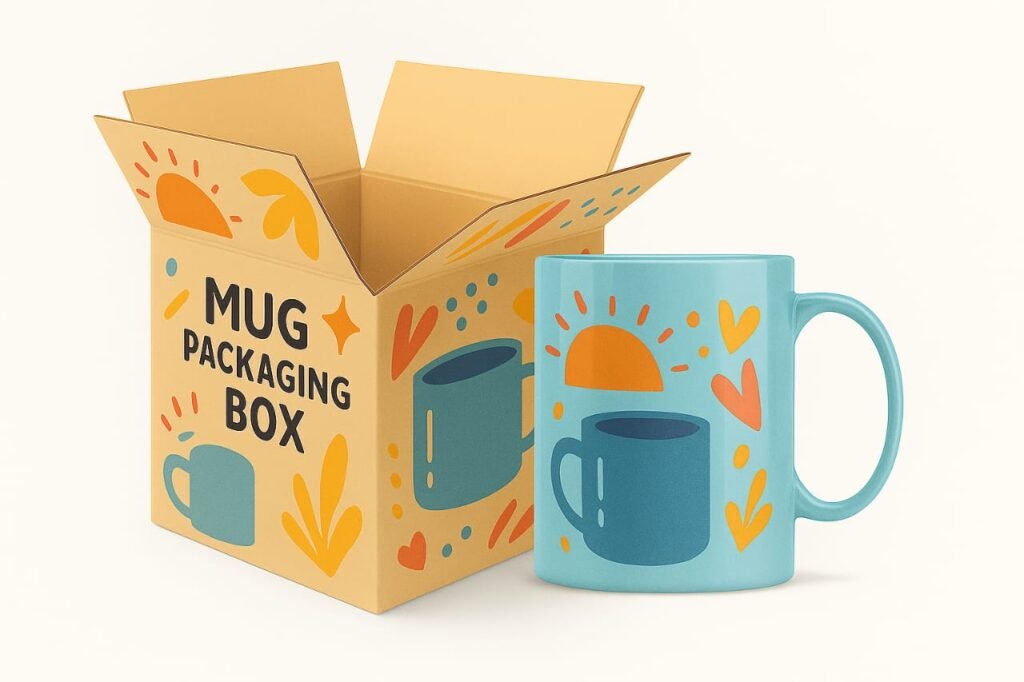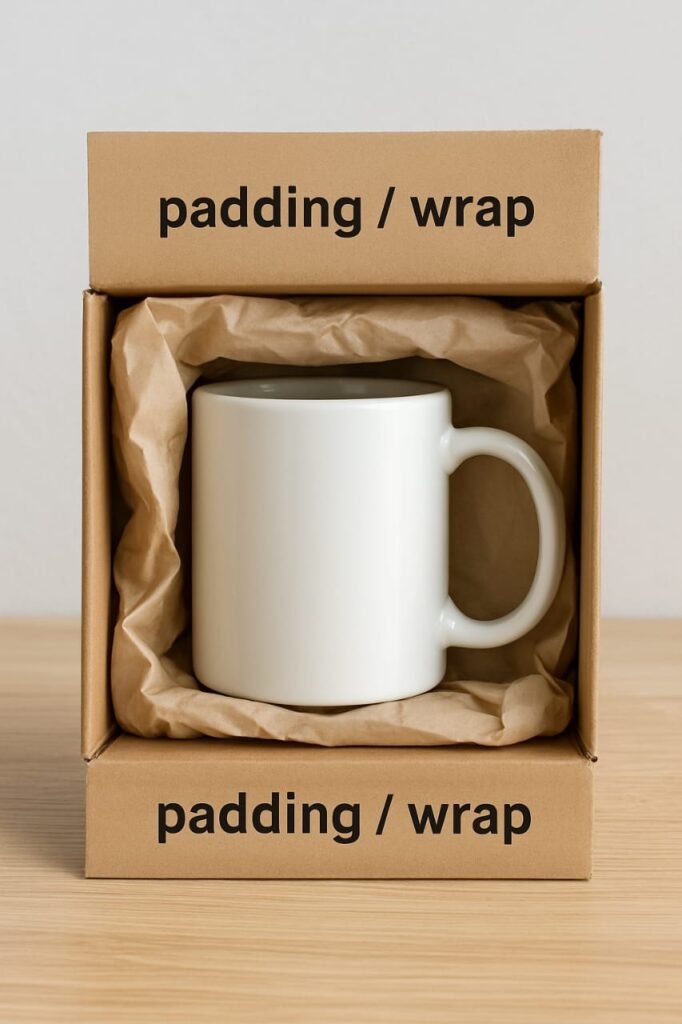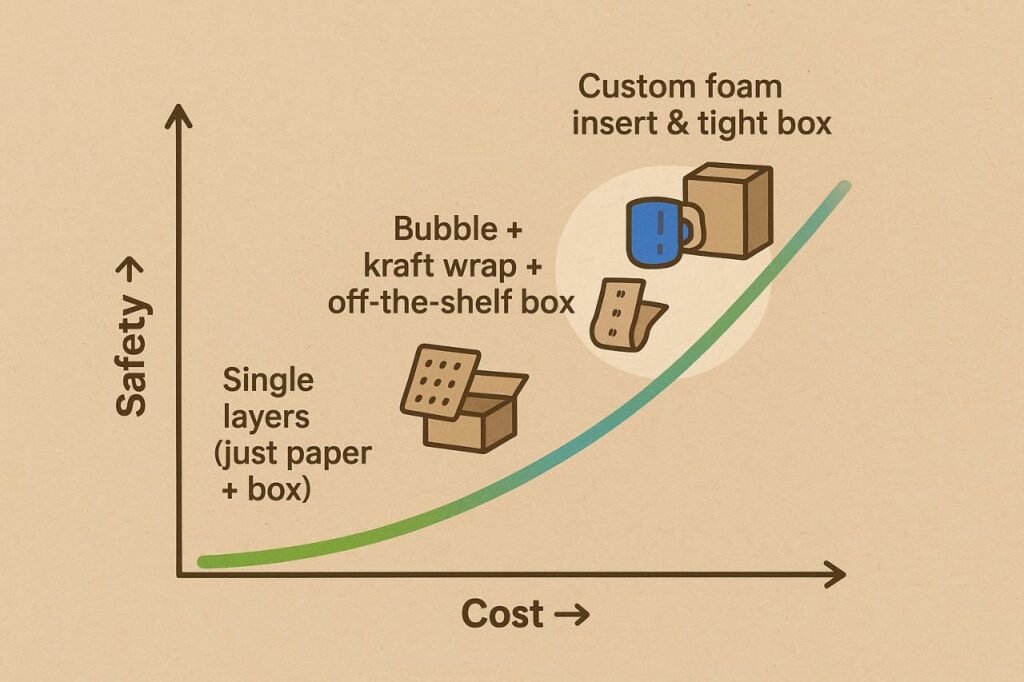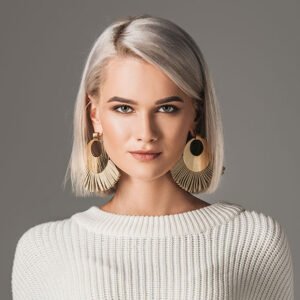
Shipping a mug sounds simple. But anyone who’s ever cracked ceramic, chipped glaze, or broken the handle during transit knows: the wrong box (or wrong packaging) can be a costly and disappointing mistake. Whether you’re running an Etsy shop, gifting to a friend, or launching your own online mug brand—choosing the right mug shipping boxes, custom mug boxes, and mug packaging boxes isn’t just about size. It’s about fit, protection, cost, and presentation.
In this post I’ll walk you through:
- How to pick the right size box for one mug (or more)
- Why custom packaging sometimes pays off
- What materials and methods prevent breakage
- Cost vs safety trade-offs you need to know
- FAQs & helpful tips
Why Box Size and Packaging Matters
Before diving into dimensions: why fuss so much? Because shipping damage is real and expensive.
- A study found that “inadequate packaging”accounts for about 30% of damaged goods during shipping. Using better fitting or tailored packaging solutions can significantly reduce damage.
- Another survey reported that 1 in 10 e-commerce packages come damaged, often due to improper packing (loose movement inside boxes, insufficient cushioning).
- Consumer perception is also at stake: in a study by Pregis & Package InSight, over 73%of participants said they’d be unlikely to buy again from a company if their parcel arrived damaged. More than 80% said product protection was the most important characteristic of packaging materials.
So, getting your mug packaging boxes right isn’t just about “not breaking things” — it’s about protecting your brand, reducing returns, and delivering satisfaction.
Measuring Your Mug
Start simple. Before picking a box size:
- Measure the mug’s height(from base to rim).
- Measure the diameter (or width)at its widest point (often rim or handle).
- Measure the handle’s projection(how far the handle sticks out).
These three are essential. Once you have them, you can add padding and clearance.
What Size Box Do I Need: Standard Guidelines
Below is a table of typical mug types, their size ranges, and what box dimensions tend to work well. These are for single mugs, assuming you’ll add cushioning around all sides and want a snug but not jammed fit.
| Mug Type / Profile | Approx Mug Size (HxD) | Recommended Box Size (L × W × H) | Notes / Why This Works |
|---|---|---|---|
| Standard 11-12 oz ceramic mug | ~4.0 in H × 3.3 in D | 5 × 5 × 5 in (≈13 × 13 × 13 cm) | Allows 0.5-1 in padding on all sides |
| Taller 15-16 oz mugs | ~4.8 in H × 4.0 in D | 5.5 × 5.5 × 6 in | Taller box gives extra room for taller mug + wrap |
| Wide mug or “soup mug” style | ~4.0 in H × 4.5 in D | 6 × 6 × 5 in | More diameter → more width & depth padding required |
| Travel mug / with lid & handle | ~6.0 in H × 3.5 in D (incl lid) | 7 × 5 × 7 in | Height is key; lid + handle can complicate fit |
| Gift set (2 mugs side by side) | 2 × standard mugs | 8 × 6 × 6 in or larger | Need divider insert so mugs don’t touch inside |
Rule of thumb: For every dimension (length, width, height), aim for at least 1 inch (≈ 2.5 cm) of protective padding (foam, bubble wrap, kraft paper) between mug and box walls.
If you want a visual:

That margin makes a difference.
Common Shipping Box Sizes & What Works for Mugs
Here are some box sizes that are commonly used for mugs, and how they map to the guidelines above. These are off-the-shelf sizes you can already buy, or order from packaging suppliers.
| Box Dimension (inches) | Typical Use / Which Mug Size It Fits Best |
|---|---|
| 5×5×5 | Standard 11-12 oz mug with good bubble wrap |
| 5.5×5.5×6 | Taller mugs, or mugs with handles that extend |
| 6×6×5 | Wider mugs or mugs with broad handles |
| 7×5×7 | Travel mugs or mugs with lids plus handle |
| 8×6×6 or larger | Gift sets, dual mug bundles, or mugs packed in gift boxes |
Custom Mug Boxes vs Off-the-Shelf
You can use regular corrugated boxes, or you can go custom. What’s the difference?
| Feature | Off-the-Shelf Mug Shipping Boxes | Custom Mug Boxes |
|---|---|---|
| Fit / Size | Fixed sizes; may have some empty space | Tailored to your exact mug + padding |
| Branding / Aesthetics | Usually plain, stock design | Can print logos, colors, taglines, etc. |
| Cost per unit | Lower for small runs | Higher setup cost; lower per unit at scale |
| Protection / Insert Options | Basic cushioning; risk of movement inside | Can design foam or pulp inserts; snug fit |
| Lead Time | Usually immediate or short | Takes design time; minimums may apply |
If you’re shipping mugs often, or shipping premium mugs (handmade, expensive, collectible), custom mug packaging boxes can make your product stand out—both in safety and in user experience.
Materials, Fillers, and Protective Techniques
Even the right‐sized box won’t help if you skimp on padding. Here are things to consider:
1.Wrap your mug well
- Use bubble wrap (thick), especially around the handle, rim, and base.
- You might wrap in kraft paper or foam sheet first, then bubble wrap.
2.Use inserts or dividers
- For multiple mugs: cardboard or foam dividers keep mugs from colliding.
- Molded pulp inserts can cradle mugs and absorb shock.
3.Fill all empty spaces
- Packing peanuts, air pillows, shredded paper, or crumpled kraft paper.
- Prevent the mug from shiftingduring transit. Movement is one of the biggest causes of breakage.
4.Cushion the bottom and top
- Extra material at the bottom of the box (often forgotten).
- The lid side also needs protection.
5.Seal and label properly
- Use strong packing tape. Reinforce box seams.
- Mark “Fragile” or “Handle With Care” if required (helps encourage gentler handling).
How Shipping Carriers & Costs Affect Box Size Choices
Choosing the box size isn’t just about safety—it also affects cost.
- Many carriers use dimensional (DIM) weightpricing. That means even if your box is light, if it’s large or has a lot of empty space, you may pay as though it’s heavy.
- Smaller boxes with the correct dimensions plus padding reduce both material cost andshipping cost.
- Also: box material matters. Double-wall corrugated boxes are stronger but cost more and weigh more. Single-wall boxes might suffice for local or gentle transit, but for long shipping routes, rough handling, or international shipments, double walls are safer.
A Quick Cost vs Safety Trade-off
Here’s a simple chart that helps you think about how safe vs costly different packaging choices can be. Higher on the “Safety” axis means better protection; higher on the “Cost” axis means more expense (materials + shipping).

You want to aim somewhere in the upper-middle: good protection without going overboard in cost.
Real-World Example / Case
Here’s a practical case from a shipping tutorial:
Someone shipping a 12-oz mug said they use a 4×4×4 inch gift box, wrap the mug in tissue paper and bubble wrap, then place that into a 6×6×6 shipping box (especially for international shipping). This combination gave enough padding to prevent damage, and the final package passed rough handling tests.
They found that the “cheap” saving by choosing too small or too flat a box almost always cost more later in replacements or customer complaints.
Summary: What’s Best for You
Here’s a quick decision guide:
1.How often do you ship mugs?
- Once in a while: use good off-the-shelf boxes + padding.
- Regularly or business scale: explore custom mug boxes; invest in a few box sizes tailored to your most common mugs.
2.What are your mugs like?
- Tall vs short, wide vs narrow, handles sticking out, with lids or not. Measure carefully.
3.What’s your budget vs risk tolerance?
- Cheaper materials/cuts may save now but cost later in breakage, returns, or unhappy customers. Aim for a balance.
4.What’s your shipping destination?
- Local shipping may be gentler; international or long courier chains often rougher—lean toward more protective packaging.
5.Test first!
- Try shipping a few mugs to yourself or friends, see what arrives. If there’s any damage, adjust padding or box size. This “trial run” method is advised in packaging-best practices.
Your Great “Mug Shipping Box” Strategy – Sample Plan
Here’s a sample plan for someone starting a small mug business:
- Order 3 box sizes:
- 5 × 5 × 5 infor standard 11-12 oz mugs
- 6 × 6 × 6 infor wider/taller mugs
- 8 × 6 × 6 infor two-mug gift sets or tall/travel mugs
- Use double-wall corrugated cardboardfor all shipping boxes.
- Wrap each mug first in kraft or foam, then bubble wrap. Focus extra wrap on handle and rim.
- Use molded pulp or cardboard inserts if shipping more than one mug.
- Test sending 5 mugs to yourself in different configurations (box sizes, padding amount) and inspect how well they survive.
- Use custom boxes later when you have repeatable types/mugs—to reduce waste and improve branding.
Final Thoughts
Choosing the right mug packaging boxes, custom mug boxes, or using standard mug shipping boxes isn’t just about getting a mug from A to B. It’s about protecting something fragile (often meaningful), delivering value, building trust, and managing cost wisely.
The correct box size—one that allows for adequate padding, snug fit, and protection—makes the difference between “arrived in perfect shape, so happy!” and “broken handle, refund, bad review.” Start with good measurements, pick good materials, test, and gradually refine. Your mugs (and your customers) will thank you.


